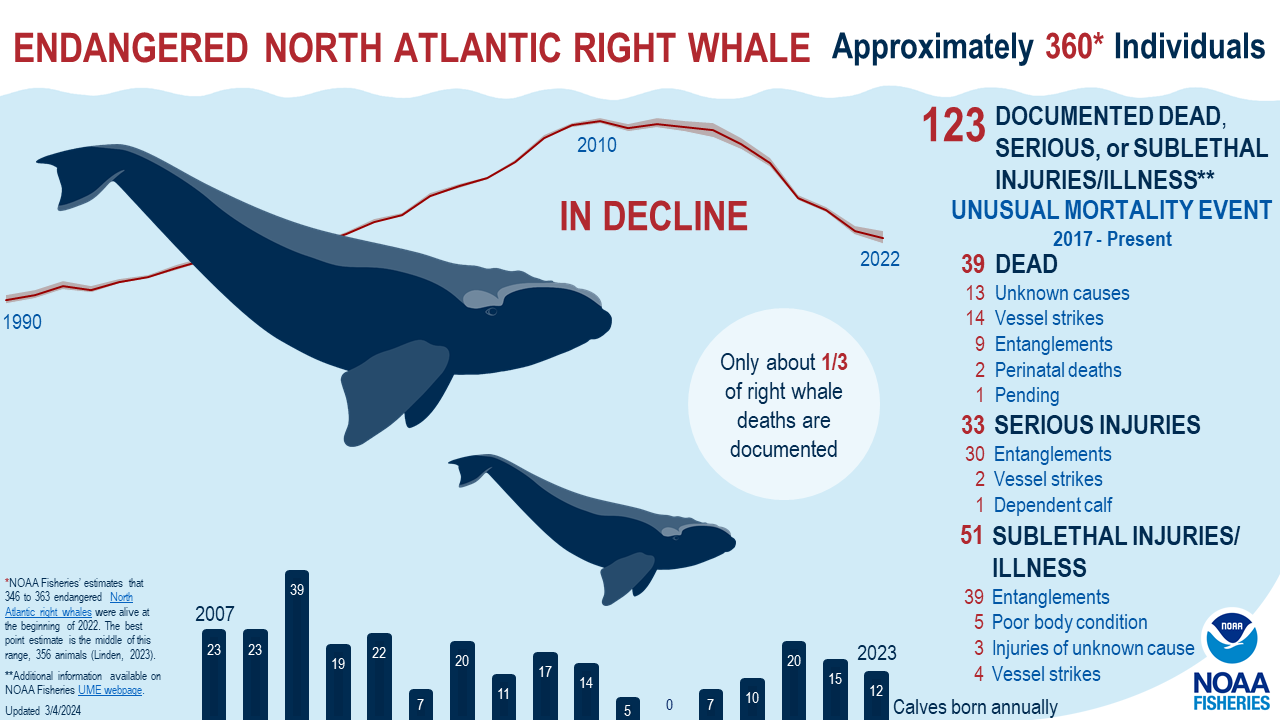Last week I participated in a North Atlantic Right Whale (NARW) Vessel Strike risk reduction workshop. This issue is really big, because the population of these iconic whales has been falling precipitously in the past few years due to ship strikes and fishing gear entanglement. Just recently their population has diminished by 35% from the peak of their post-whaling population recovery of 2010 (from ~565 individuals to ~350 this year).
And only last week we lost a recently born calf to a ship strike. Heartbreaking.
The workshop was urgent, and well attended. Hosted by NOAA Fisheries, and attended by stakeholders from the shipping and fishing industries, mariners, environmental groups, engineering firms, and government agencies. As a remote attendee I could only estimate that there were maybe 80 attendees, but was impressed by the enthusiasm and sincerity of all of them; and that many of them were from the “A-list” of folks I have worked around for years.
I frame this because the NARW issue is something OCR has not really taken on (for reasons I’ll explain below). But the noise I have been hearing in the periphery of the discussion has been mostly stubbing its toes on the “10 knot speed reduction” request – which industry has been attempting to thwart at all intersections. So having mariners and shippers expressing concern about the survival of these animals is a breath of fresh air.
And the various technologies and strategies expressed in the workshop were illuminating: Satellites, drones, Autonomous Underwater Vehicles (AUV), Passive Acoustic Monitoring (PAM), and “Artificial Intelligence” data synthesis were all parts of the discussion. Even a predictor system that harvested enzymes in seawater associated with zooplankton activity to estimate regional NARW population density.
A lot of great ideas. And with so many flashing red lights in the dashboard, none too soon. But the survival of these animals… this is another issue. There is no clear reason why the population turned for the worse after 2010, but the trend is troubling. The proposal of deploying some 3000 wind turbines along the Atlantic coast in the near future will not alleviate the stress, conflicts, or interference in these animal’s lives.
Regardless of any noise mitigation strategies deployed, there is not a lot of difference between millions of pile-driving strikes and the millions of airgun blasts that played a role in our halting South Atlantic offshore oil a few years back. Adding to this; there will be so many more survey, construction, and service vessels tending the turbines all along the Atlantic Outer Continental Shelf (OCS) for the next foreseeable future.
I said something really unpopular at one of these NARW workshops a while back. I proclaimed that the NARW would not survive our best laid plans. Of course I would love to be proved wrong, but when we don’t know why a population crashes by 35% in a few years, any speculation about how we can save them is just window dressing.
Near the conclusion of the workshop a woman chimed in. I didn’t catch her affiliation, but she may have been tribal Lenape from the New York area. In any event she was representing an indigenous perspective.
What she said was not really a statement, or really a prayer. But she let us all know that the Right Whales were not “Navigation Hazards,” rather they are our relatives. We have a responsibility to treat them as such.
She also mentioned the Gray Whale that was recently seen plying the waters of the Atlantic Coast. She told us that this whale was checking us out; seeing how we were doing as their Western Pacific Sakhalin habitats are being surrendered to fossil fuel extraction.
There are a lot of talented people focused on the Atlantic OCS whale habitat. Our relatives are letting us know that we need to do better.

